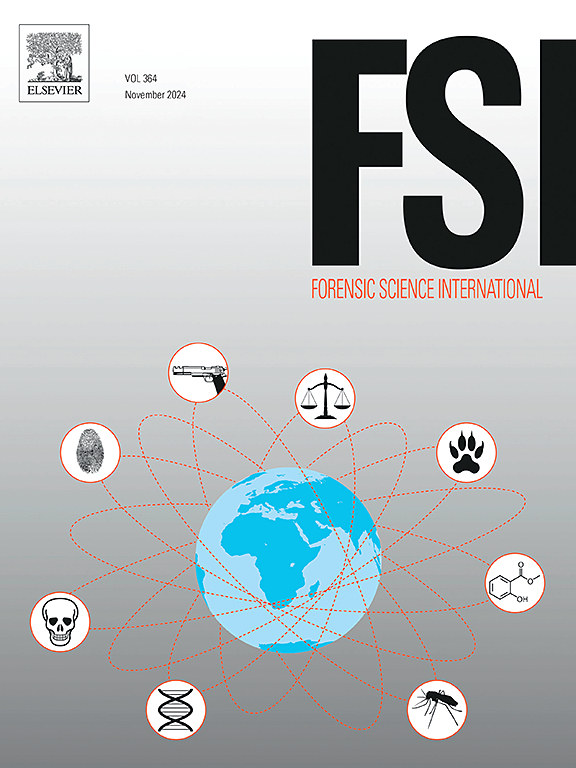Assessment of a combined handheld Raman spectroscopy and transportable mass spectrometry approach for the analysis of seized drug mixtures
IF 2.2
3区 医学
Q1 MEDICINE, LEGAL
引用次数: 0
Abstract
Growing backlogs and lengthy turnaround times for seized drug analysis are causing significant strain on the judicial system. One potential solution is to improve field screening through on-site detection methods using field-portable instrumentation to reduce the amount of evidence submissions to forensic laboratories. However, incorporating field-portable instrumentation into routine on-site detection requires empirical data to establish each instrument's capabilities, limitations, and performance characteristics. This study evaluates using handheld Raman and transportable linear ion trap mass spectrometry instrumentation under controlled laboratory conditions to identify seized drug mixtures. A Rigaku ResQ-CQL handheld Raman spectrometer, a Field Forensics HandyRam™ handheld Raman spectrometer, and a BaySpec Continuity™ linear ion trap mass spectrometer were used to analyze seized drug mixtures. The analyzed mixtures contained cocaine or methamphetamine with levamisole, procaine, caffeine, and phenacetin at 1:1, 1:4, 1:10, and 1:20 ratios. The ability to identify controlled substances using the onboard library was evaluated for the ResQ-CQL and the Continuity™ instruments. Using the ResQ-CQL, only pure compounds and several of the 1:1 ratio mixtures had more than 85 % accuracy in identifying the controlled substance. In contrast, the Continuity™ demonstrated the ability to identify the controlled substance in the 1:4 and 1:10 ratio mixtures. When the data from the ResQ-CQL and the Continuity™ were considered together, an accuracy of at least 67 % was achieved for the 1:1, 1:4, and 1:10 mixtures. 100 % accuracy was achieved when the combined method was applied to identifying controlled substances in authentic destroyed casework samples.
评估手持式拉曼光谱和可移动质谱联用方法对检获药物混合物的分析
越来越多的积压案件和漫长的周转时间给司法系统带来了巨大压力。一个可能的解决办法是通过使用现场便携式仪器的现场检测方法来改进现场筛选,以减少向法医实验室提交证据的数量。然而,将现场便携式仪器纳入常规现场检测需要经验数据来确定每种仪器的能力、局限性和性能特征。本研究评估了在受控的实验室条件下使用手持式拉曼和可移动的线性离子阱质谱仪器来识别查获的药物混合物。使用Rigaku ResQ-CQL手持式拉曼光谱仪、Field Forensics HandyRam™手持式拉曼光谱仪和BaySpec Continuity™线性离子阱质谱仪分析查获的药物混合物。被分析的混合物中含有可卡因或甲基苯丙胺与左旋咪唑、普鲁卡因、咖啡因和非那西丁的比例分别为1:1、1:4、1:10和1:20。对ResQ-CQL和Continuity™仪器使用机载文库识别受控物质的能力进行了评估。使用ResQ-CQL,只有纯化合物和几种1:1比例的混合物对受控物质的识别准确度超过85% %。相比之下,Continuity™证明了在1:4和1:10比例混合物中识别受控物质的能力。当ResQ-CQL和Continuity™的数据一起考虑时,1:1,1:4和1:10混合物的精度至少达到67 %。当联合方法用于鉴定真实销毁案例样品中的受控物质时,准确度达到100% %。
本文章由计算机程序翻译,如有差异,请以英文原文为准。
求助全文
约1分钟内获得全文
求助全文
来源期刊

Forensic science international
医学-医学:法
CiteScore
5.00
自引率
9.10%
发文量
285
审稿时长
49 days
期刊介绍:
Forensic Science International is the flagship journal in the prestigious Forensic Science International family, publishing the most innovative, cutting-edge, and influential contributions across the forensic sciences. Fields include: forensic pathology and histochemistry, chemistry, biochemistry and toxicology, biology, serology, odontology, psychiatry, anthropology, digital forensics, the physical sciences, firearms, and document examination, as well as investigations of value to public health in its broadest sense, and the important marginal area where science and medicine interact with the law.
The journal publishes:
Case Reports
Commentaries
Letters to the Editor
Original Research Papers (Regular Papers)
Rapid Communications
Review Articles
Technical Notes.
 求助内容:
求助内容: 应助结果提醒方式:
应助结果提醒方式:


